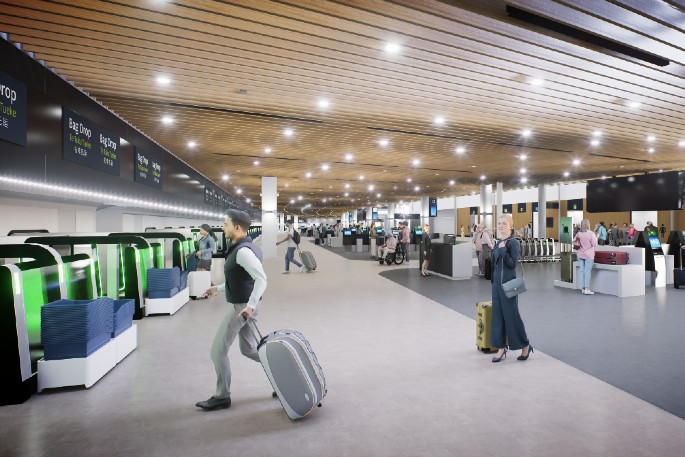This Content Is Only For Subscribers
Gone will be the days of long queues at traditional airline counters or changing terminals to make a connecting jet flight at New Zealand’s gateway airport.
Auckland Airport has unveiled plans for a sweeping check-in upgrade that lays the digital foundations for a technology-led travel future and brings domestic jet and international travellers together under one roof for the first time since the 1970s.
Over the next four years, the existing check-in hall will be transformed, turning it into a 13,000m2 digital, user-focused departures area designed for the modern traveller. Practical and welcoming, an improved layout and flow will remove traditional queuing and create an intuitive, inviting start to the journey.
Auckland Airport chief executive Carrie Hurihanganui says it is a milestone moment in the airport’s rebuild, signalling the next major phase of development.
“This is a once-in-a-generation opportunity to completely reimagine the check-in experience and ensure New Zealand’s gateway airport is fit for the future,” she says.
“We’re delivering what travellers now expect from the world’s leading airports – a fast, seamless check-in experience, powered by smart technology and supported by great people.
“Alongside expanding the check-in space, we’re introducing a digital overhaul that will smooth the experience for travellers and sets us on the path to adopting future technologies such as biometrics.
“It’s a big change and as we prepare for the future, we’re modernising right to the core of our systems.”
From traditional check-in counters to digital experience
Globally travellers are prioritising speed and convenience supported by technology. Surveys show 77 per cent of travellers are interested in using a smartphone loaded with a digital passport and wallet for booking, payment and travel information – rising to 90 per cent among under-25s.
For airlines, the technology brings the ability to automate document checks, reduce manual processing and cut the risk of ineligible travellers reaching the gate.
“Internationally we are seeing work towards digital passports and digital travel credentials, integrating biometric data and cryptographic algorithms to ensure information is kept private and secure. Building on ePassports, this technology allows for a more streamlined, faster authorisation at processing points such as check-in, border transitions and aircraft boarding.”
The project will centre on introducing common-use self-service kiosk and automated bag drops, replacing around 60 traditional check-in desks between now and the opening of the domestic jet terminal at the end of this decade.
“This is the direction airports globally are heading with Changi Airport, Dubai and Heathrow all showing how terminal upgrades drive the shift to self-service,” says Carrie.
The technology has already been rolled out in one check-in zone, replacing 30 desks with 36 kiosks and 22 bag drops. Feedback from early-adopter airlines has been used to refine the design and processes for the wider rollout.
An important feature is common-use flexibility. The new kiosks and bag drops can be used by different airlines throughout the day, improving efficiency and reducing infrastructure duplication.
All under one roof
Currently 27 airlines operate from the international terminal, flying to 42 overseas cities. Once the new domestic terminal opens, jet flights to New Zealand cities will also check in through this centralised, modernised space.
“While we will be expanding and refreshing the terminal, moving away from traditional desk-based check-in gives us the opportunity to free up floor space, ease queuing pressure and improve flow,” says Carrie.
The shift to common use, not just in check-in, but across the terminal design and operation, also lowers barriers to entry for new airlines, supporting greater competition and choice for travellers.
“We’re also focused on delivering infrastructure that’s cost-effective both to build and to run. Flexible, shared-use spaces are key to making that happen.”
Managing through disruption
Major activity will take place on the front face of the terminal, expanding the footprint by 2,800m2 to support improved traveller amenities, improve pedestrian flows and form the connection with the domestic jet terminal currently under construction alongside.
Inside, staged construction activity will move through the check-in area, refreshing the interior while upgrading the check-in technology.
To maintain capacity during the phased construction, a temporary check-in pavilion will be built adjoining the Transport Hub. Work on the pavilion begins later this year, with main construction on the terminal check-in areas starting early 2026.
“It’s a complex project but the health and safety of travellers and airport workers is our number one focus, along with keeping the system running smoothly. We’re working closely with airlines on how we operate through the change,” says Carrie.
“The result will be worth it when we deliver a travel experience that’s up there with the world’s leading airports.”
For the latest information, travellers are encouraged to visit the new AKL website: https://corporate.aucklandairport.co.nz/futureakl.



